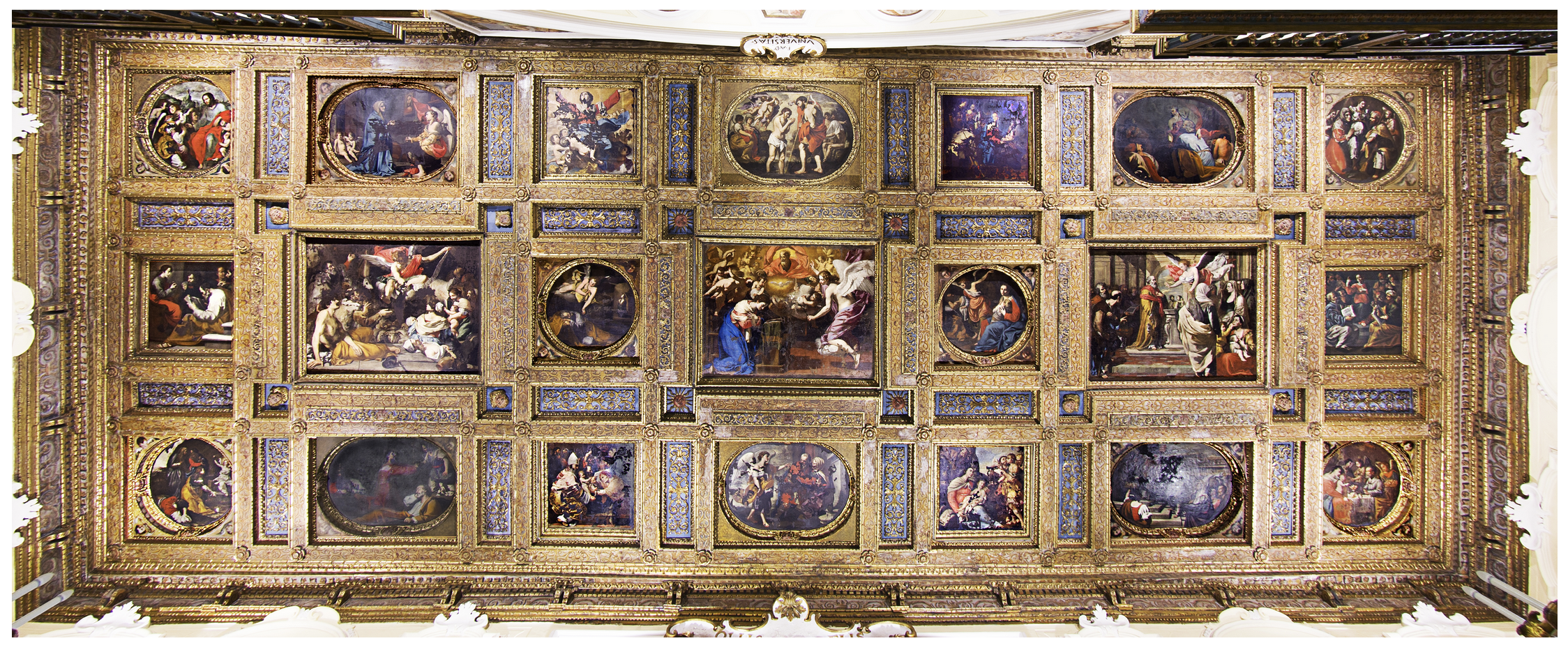To my family members (and interested friends):
Our cousin Alfonso Buongiorno, whom we met in Italy in 2018, recently sent me this link to a website that features the paintings on the ceiling of the Collegiata church in Solofra, Avellino, Italy, our Troisi and Buongiorno hometown.
Check out this amazing presentation, everyone. Click on any panel for a fabulous enlargement–that enlarges even more!
I think all the scenes are episodes from the life of Christ. Curiously, none are of St. Michael the Archangel, whom the church is named for and who is featured EVERYwhere else (behind the altar, on the exterior doors, etc.) It makes me wonder if they dedicated and named the church after the ceiling was done, maybe? If I could actually read Italian, I might be able to figure this out.
I’m fascinated by the putti characters in some scenes, and in the frames around other scenes. Their faces, and even the faces of the major characters, look like portraits of real people to me. Do any of them look like Buongiornos or Troisis we know? Both of our families were in Solofra by this time (1600s).
The painters of the images in this church were a father and son pair of local men named Guarino or Guarini (they aren’t sure which, seriously, or maybe both names were used by each at different times, I’m not sure) who both studied in Naples with Caravaggio. The Caravaggio influence is clear by the “realness” of the portraits (figures’ faces) and by the dramatic lighting in several of these images, AND we had a Caravaggio lesson from Lucia Petrone when we were in the church. Check out the detail about a figure’s dirty feet here: https://feetonthegroundnyc.com/we-meet-lucia-petrone/
Did neither of these painters ever grab a little Troisi boy (Grandpa’s great-great-great-something) to model for them and memorialize forever??? (It’s my fantasy that we are going to see someone we recognized one of these days in one of these paintings, if we just keep looking….)
By the way, our great-grandfather Beniamino Troisi’s mother’s maiden name was Guarino, so maybe we are descended from these famous artists! I don’t know if it’s likely, or if it’s a common name in town and, therefore, not likely. I haven’t gotten close enough to any of our Solofra contacts, and my Italian isn’t good enough, to sort that out, but it’s on my list of details to nail down (I hope) on my next trip.

What a fascinating site! With the exception of the corner scenes, Liberation of Peter, these are scenes are biblical and traditional scenes around the family of Jesus, not the whole life. It seems to be quite centered on Jesus life outside of his ministry, and especially Mary and Joseph’s involvement, as well as the grandparents.
With some help from Google translate they are (Left to Right, Top to Bottom)
Top Row
– Jesus among the angels in the desert
– Announcement to Mary of the Resurrection
– The Assumption (of Mary)
– The Baptism of Christ
– The Adoration of the Shepherds
– The Liberation of Peter (from jail, in the Acts of the APostles)
– Anna, Joachim and the Angels (Jesus’ grandparents)
Middle Row
– Jesus disputation with the doctors (learned men)
– Annunciation to the Shepherds
– Joseph’s Dream
– The Annunciation
– Annunciation to Joseph of the Flight into Egypt
– Annunciation to Zechariah (of the birth of John the Baptist)
– Jesus among the doctors (at the age of 12)
Bottom Row
– The pious women at the sepluchre/grave
– Christ in the garden of Gethsemane
– The circumcision
– The Annunciation to Anna and Joachim
– Rest in Egypt
– Presentation of the virgin in time (no idea what this is)
– Joseph’s supper
It is not a surprise that Michael the Archangel is not there. These are New Testament scenes and the archangel Michael does not really show up in the New Testament. It would have been confusing to have included him in a set of New Testament scenes. Since this kind of artwork was frequently used for catechesis, it would be strange to have inserted Michael here, where he does not belong, even if the church was named for him. In those days, the art’s first job is to tell the biblical story, because parishioners are not able to read it themselves (that happened later, and largely grew out of the Reformation and, in Italy, Counter-Reformation.
It is sad to see that some of these are not in very good shape.
Julie, thank you! I was hoping you would weigh in with some explanations. Fabulous.